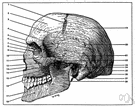pterygoid process
(ˈtɛrɪˌɡɔɪd) n (Anatomy) anatomy either of two long bony plates extending downwards from each side of the sphenoid bone within the skull
[C18 pterygoid, from Greek pterugoeidēs, from pterux wing; see -oid]
Collins English Dictionary – Complete and Unabridged, 12th Edition 2014 © HarperCollins Publishers 1991, 1994, 1998, 2000, 2003, 2006, 2007, 2009, 2011, 2014
ThesaurusAntonymsRelated WordsSynonymsLegend:
| Noun | 1. |  pterygoid process - two bony processes descending from the body of the sphenoid bone pterygoid process - two bony processes descending from the body of the sphenoid boneappendage, outgrowth, process - a natural prolongation or projection from a part of an organism either animal or plant; "a bony process" |
Based on WordNet 3.0, Farlex clipart collection. © 2003-2012 Princeton University, Farlex Inc.
All content on this website, including dictionary, thesaurus, literature, geography, and other reference data is for informational purposes only. This information should not be considered complete, up to date, and is not intended to be used in place of a visit, consultation, or advice of a legal, medical, or any other professional.
 pterygoid process - two bony processes descending from the body of the sphenoid bone
pterygoid process - two bony processes descending from the body of the sphenoid bone